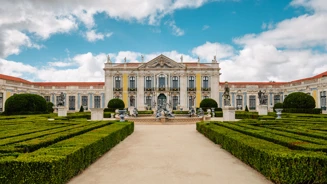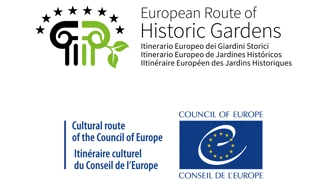The History of the Gardens and National Palace of Queluz

In 1654, João IV established the Casa do Infantado, which included the Queluz Country House, built on a commission from the first Marquis of Castelo Rodrigo, Cristóvão de Moura, and confiscated in the wake of the Restoration of Independence in 1640. The Casa do Infantado was a seigniory created for the second-born sons of the Portuguese monarchs, the princes who were destined not to be the heirs to the Crown, thus enabling them to have their own property and income. Around that time, the property was given to Prince Pedro, the first Lord of the Casa do Infantado and future King Pedro II.
In 1747, Prince Pedro, third Lord of the Casa do Infantado and future King Pedro III (on his marriage to Queen Maria I) appoints the architect Mateus de Vicente de Oliveira to expand what was then called the “Old Palace”. Years later, in 1760, the announcement of the marriage of Pedro to the heir to the throne, Princess Maria was cause for more extensive expansion works that sought to endow the property with the nobility of a royal palace. In this phase, the construction was under the supervision of the architect and goldsmith Jean-Baptiste Robillion. Removed from the politics and intrigues of the court, and in possession of both a considerable fortune and refined habits, Pedro III dedicated his attentions to this site, transforming it into a place for the leisure and recreation of the Royal Family and installing a series of reception halls, such as the Throne Room and the Ambassadors Room. In the gardens, the decoration is characterised by the series of sculptural groups evoking classical mythology, with the lead statues from the London workshop of John Cheere representing one particularly highlight.
Following the 1794 blaze that destroyed the Royal Complex of Ajuda, which had been the Royal Family’s permanent residence ever since the earthquake of 1755, the Palace of Queluz became the official resident of Queen Maria I – who was widowed in the meantime – and, subsequently, the Prince Regents João VI and Carlota Joaquina, who stipulated the adaptation of some interior spaces and the construction of new buildings to accommodate the Court, the Royal Guard and their entourage of servants. Queluz thus also became the site where the Court would go to spend their leisure time, attending serenades, horse races and firework displays.
The palace was permanently inhabited through to the departure of the Royal Family for Brazil at the time of the Napoleonic invasion in 1807, and just one day before French troops entered Lisbon under the command of General Junot. It is said that in this same year, Junot himself visited the palace and this led to the hope of his one day welcoming and installing Napoleon Bonaparte in residence there.
In 1821, King João VI returned to Portugal but the palace would only again be inhabited under a regime of semi-exile by Queen Carlota Joaquina, accused of conspiring against her husband. Furthermore, there was never any return to the golden times of this palace and never again were its halls and gardens so animated by court parties and celebrations.
The following generation, shaped by the Civil War that pitted Miguel against his brother, King Pedro IV of Portugal and first emperor of Brazil, closed the period of royal residence in the Palace of Queluz. Miguel, a defender of the absolutist cause, lived in the palace in the period he was king and during the bloody civil war in which he confronted Pedro IV, his brother who fought for the advent of constitutional liberalism. Pedro was to win the war but, on the grounds of illness, abdicated the throne of Portugal in favour of his young daughter, Maria II. It was in the Palace of Queluz, in the Don Quixote Room, where he had been born, that Pedro IV ended up passing away.
Years later, in 1910, the National Palace of Queluz was classified as a National Monument. As from 1957, the D. Maria I Pavilion, the eastern wing of the palace, began to serve the function of residence to heads of state making official visits to Portugal.
In 1979, the Portuguese School of Equestrian Art, with the purpose of fostering the teaching, practice and dissemination of traditional Portuguese Equestrian Art, opened its headquarters in the palace gardens.
Parques de Sintra took over the management of the monument in 2012 and, one year later, it became a member of the European Royal Residences Network.
Currently, the National Palace of Queluz and its historical gardens constitute one of the leading examples of the harmonious connections between landscape and palatial architecture in Portugal, which requires preserving. Parques de Sintra has undertaken a series of restoration and renovation projects of which we would highlight the interventions made to the facades, which returned the palace to its original blue colour, and the rehabilitation of the Botanical Garden, a project that in 2018 won an unprecedented two European Union Awards for Cultural Heritage / Europa Nostra Awards: in the categories of Conservation and the Public Choice Award.
The Portuguese School of Equestrian Art remains headquartered in the palace gardens. In order to foster the study of this art and the regular training of riders, in 2015, Parques de Sintra established the only national library dedicated exclusively to Equestrian Art in the National Palace of Queluz. The D. Diogo de Bragança, VIII Marquis of Marialva Equestrian Art Library contains over 1,400 works, including various rare editions and copies.
The National Palace and Gardens of Queluz are integrated in the "European Route of Historic Gardens", within the “Cultural Routes of the Council of Europe” since 2020.
The Cultural Routes programme, launched by the Council of Europe in 1987, demonstrates in a visible way, by means of a journey through space and time, how the heritage of the different countries and cultures of Europe represent a share cultural heritage. The Cultural Routes put into practice the fundamental values of Council of Europe: human rights, cultural democracy, cultural diversity and identity, dialogue, mutual exchange and enrichments across boundaries and centuries. As of 2020, there are 40 certified Cultural Routes of the Council of Europe (www.coe.int/routes).

